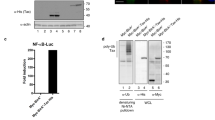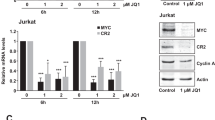Abstract
The polyomavirus middle T antigen (PyMT) is an oncogene that activates the non-receptor tyrosine kinase, c-Src, and physically interacts with Taz (WWTR1). Taz is a pro-oncogenic transcription coactivator of the Tead transcription factors. The Hippo tumor suppressor pathway activates the kinase Lats, which phosphorylates Taz, leading to its nuclear exclusion and blunting Tead coactivation. We found that Taz was required for transformation by PyMT, but counter-intuitively, Taz was exclusively cytoplasmic in the presence of PyMT. We demonstrate that in the presence of PyMT, wild-type Taz was phosphorylated by Lats, in a Src-dependent manner. Consistently, a Lats refractory Taz mutant did not undergo cytoplasmic retention by PyMT. We show that Yap, the Taz paralog, and Shp2 phosphatase were nuclear excluded as well. Our findings describe a noncanonical activation of Lats, and an unprecedented Tead-independent role for Taz and Yap in viral-mediated oncogenesis.
This is a preview of subscription content, access via your institution
Access options
Subscribe to this journal
Receive 50 print issues and online access
$259.00 per year
only $5.18 per issue
Buy this article
- Purchase on Springer Link
- Instant access to full article PDF
Prices may be subject to local taxes which are calculated during checkout







Similar content being viewed by others
References
O'Shea CC . DNA tumor viruses—the spies who lyse us. Curr Opin Genet Dev 2005; 15: 18–26.
Helt A-M, Galloway DA . Mechanisms by which DNA tumor virus oncoproteins target the Rb family of pocket proteins. Carcinogenesis 2003; 24: 159–169.
Fluck MM, Schaffhausen BS . Lessons in signaling and tumorigenesis from polyomavirus middle T antigen. Microbiol Mol Biol Rev 2009; 73: 542–563.
Treisman R, Novak U, Favaloro J, Kamen R . Transformation of rat cells by an altered polyoma virus genome expressing only the middle-T protein. Nature 1981; 292: 595–600.
Guy CT, Cardiff RD, Muller WJ . Induction of mammary tumors by expression of polyomavirus middle T oncogene: a transgenic mouse model for metastatic disease. Mol Cell Biol 1992; 12: 954–961.
Gottlieb KA, Villarreal LP . Natural biology of polyomavirus middle T antigen. Microbiol Mol Biol Rev 2001; 65: 288–318.
Courtneidge SA, Smith AE . The complex of polyoma virus middle-T antigen and pp60c-src. EMBO J 1984; 3: 585–591.
Guy CT, Muthuswamy SK, Cardiff RD, Soriano P, Muller WJ . Activation of the c-Src tyrosine kinase is required for the induction of mammary tumors in transgenic mice. Genes Dev 1994; 8: 23–32.
Harvey R, Oostra BA, Belsham GJ, Gillett P, Smith AE . An antibody to a synthetic peptide recognizes polyomavirus middle-T antigen and reveals multiple in vitro tyrosine phosphorylation sites. Mol Cell Biol 1984; 4: 1334–1342.
Kamps MP, Buss JE, Sefton BM . Mutation of NH2-terminal glycine of p60src prevents both myristoylation and morphological transformation. Proc Natl Acad Sci USA 1985; 82: 4625–4628.
Schaffhausen B, Benjamin TL . Comparison of phosphorylation of two polyoma virus middle T antigens in vivo and in vitro. J Virol 1981; 40: 184–196.
Zhao B, Wei X, Li W . Inactivation of Yap oncoprotein by the Hippo pathway is involved in cell contact inhibition and tissue growth control. Genes Dev 2007; 21: 2747–2761.
Zeng Q, Hong W . The emerging role of the hippo pathway in cell contact inhibition, organ size control, and cancer development in mammals. Cancer Cell 2008; 13: 188–192.
Hao Y, Chun A, Cheung K, Rashidi B, Yang X . Tumor suppressor LATS1 is a negative regulator of oncogene YAP. J Biol Chem 2007; 283: 5496–5509.
Liu C-Y, Zha Z-Y, Zhou X, Zhang H, Huang W, Zhao D et al. The hippo tumor pathway promotes TAZ degradation by phosphorylating a phosphodegron and recruiting the SCFβ-TrCP E3 ligase. J Biol Chem 2010; 285: 37159–37169.
Zhao B, Ye X, Yu J, Li L, Li W, Li S et al. TEAD mediates YAP-dependent gene induction and growth control. Genes Dev 2008; 22: 1962–1971.
Mahoney WMJ, Hong J-H, Yaffe MB, Farrance IKG . The transcriptional co-activator TAZ interacts differentially with transcriptional enhancer factor-1 (TEF-1) family members. Biochem J 2005; 388: 217–225.
Lei Q-Y, Zhang H, Zhao B, Zha Z-Y, Bai F, Pei X-H et al. TAZ promotes cell proliferation and epithelial-mesenchymal transition and is inhibited by the hippo pathway. Molec Cell Biol 2008; 28: 2426–2436.
Kanai F, Marignani PA, Sarbassova D, Yagi R, Hall RA, Donowitz M et al. TAZ: a novel transcriptional co-activator regulated by interactions with 14-3-3 and PDZ domain proteins. EMBO J 2000; 19: 6778–6791.
Zhao B, Li L, Tumaneng K, Wang CY, Guan KL . A coordinated phosphorylation by Lats and CK1 regulates YAP stability through SCF(beta-TRCP). Genes Dev 2010; 24: 72–85.
Dong J, Feldmann G, Huang J, Wu S, Zhang N, Comerford SA et al. Elucidation of a universal size-control mechanism in drosophila and mammals. Cell 2007; 130: 1120–1133.
Halder G, Johnson RL . Hippo signaling: growth control and beyond. Development 2011; 138: 9–22.
Tian Y, Li D, Dahl J, You J, Benjamin T . Identification of TAZ as a Binding Partner of the Polyomavirus T Antigens. J Virol 2004; 77: 12657–12664.
Glenn GM, Eckhart W . Amino-terminal regions of polyomavirus middle T antigen are required for interactions with protein phosphatase 2A. J Virol 1995; 69: 3729–3736.
Cook DN, Hassell JA . The amino terminus of polyomavirus middle T antigen is required for transformation. J Virol 1990; 64: 1879–1887.
Campbell KS, Auger KR, Hemmings BA, Roberts TM, Pallas DC . Identification of regions in polyomavirus middle T and small t antigens important for association with protein phosphatase 2A. J Virol 1995; 69: 3721–3728.
Tsutsumi R, Masoudi M, Takahashi A, Fujii Y, Hayashi T, Kikuchi I et al. YAP and TAZ, Hippo signaling targets, act as a rheostat for nuclear SHP2 function. Dev Cell 2013; 26: 658–665.
Yang Y, Jiang B, Huo Y, Primo L, Dahl JS, Benjamin TL et al. Shp2 suppresses PyMT-induced transformation in mouse fibroblasts by inhibiting Stat3 activity. Virology 2011; 409: 204–210.
Ota M, Sasaki H . Mammalian Tead proteins regulate cell proliferation and contact inhibition as transcriptional mediators of Hippo signaling. Development 2008; 135: 4059–4069.
Zhao B, Kim J, Ye X, Lai ZC, Guan KL . Both TEAD-binding and WW domains are required for the growth stimulation and oncogenic transformation activity of yes-associated protein. Cancer Res 2009; 69: 1089–1098.
Schaffhausen BS, Roberts TM . Lessons from polyoma middle T antigen on signaling and transformation: A DNA tumor virus contribution to the war on cancer. Virology 2009; 384: 304–316.
Dilworth SM . Polyoma virus middle T antigen: meddler or mimic? Trends Microbiol 1995; 3: 31–35.
Raptis L, Lamfrom H, Benjamin TL . Regulation of cellular phenotype and expression of polyomavirus middle T antigen in rat fibroblasts. Mol Cell Biol 1985; 5: 2476–2486.
Lei QY, Zhang H, Zhao B, Zha ZY, Bai F, Pei XH et al. TAZ promotes cell proliferation and epithelial-mesenchymal transition and is inhibited by the Hippo pathway. Mol Cell Biol 2008; 28: 2426–2436.
Primo L, Roca C, Ferrandi C, Lanfrancone L, Bussolino F . Human endothelial cells expressing polyoma middle T induce tumors. Oncogene 2000; 19: 3632–3641.
Williams RL, Risau W, Zerwes HG, Drexler H, Aguzzi A, Wagner EF . Endothelioma cells expressing the polyoma middle T oncogene induce hemangiomas by host cell recruitment. Cell 1989; 57: 1053–1063.
Grazia Lampugnani M, Zanetti A, Corada M, Takahashi T, Balconi G, Breviario F et al. Contact inhibition of VEGF-induced proliferation requires vascular endothelial cadherin, beta-catenin, and the phosphatase DEP-1/CD148. J Cell Biol 2003; 161: 793–804.
Levy D, Adamovich Y, Reuven N, Shaul Y . The Yes-associated protein 1 stabilizes p73 by preventing Itch-mediated ubiquitination of p73. Cell Death Differ 2007; 14: 743–751.
Morgenstern JP, Land H . Advanced mammalian gene transfer: high titre retroviral vectors with multiple drug selection markers and a complementary helper-free packaging cell line. Nucleic Acids Res 1990; 18: 3587–3596.
Carey MF, Peterson CL, Smale ST . Dignam and Roeder nuclear extract preparation. Cold Spring Harb Protoc 2009; 2009: pdb prot5330.
Acknowledgements
We thank Drs R Bassel-Duby for pCDNA3-Flag-mTaz, pCDNA-myc-mTaz and pCDNA-myc-mTazWA plasmids; M Sudol for pCMV-Yap1 plasmid; J Zhang for pBP-GFP-hTaz-4SA plasmid; H Sasaki for pBS-8xGTIIC-Luc (8xGTIIC) Tead reporter plasmid; A Elson for mSrc sequence; M Oren for Myc-tagged human Lats2 constructs; and XJ Yang for HA-tagged Lats2, Lats-KM, Mst1 and WW45 constructs; B Neel for Shp2 C459S and E76K constructs. We thank Dr Z Porat for his help with ImageStream technology. This work was supported by grants from the Israel Science Foundation (grant No. 551/11), Israel Cancer Research Fund and from the Minerva Foundation with funding from the Federal German Ministry for Education and Research.
Author information
Authors and Affiliations
Corresponding author
Ethics declarations
Competing interests
The authors declare no conflict of interest.
Additional information
Supplementary Information accompanies this paper on the Oncogene website
Rights and permissions
About this article
Cite this article
Shanzer, M., Ricardo-Lax, I., Keshet, R. et al. The polyomavirus middle T-antigen oncogene activates the Hippo pathway tumor suppressor Lats in a Src-dependent manner. Oncogene 34, 4190–4198 (2015). https://doi.org/10.1038/onc.2014.347
Received:
Revised:
Accepted:
Published:
Issue Date:
DOI: https://doi.org/10.1038/onc.2014.347
This article is cited by
-
Src mediates β-adrenergic receptor induced YAP tyrosine phosphorylation
Science China Life Sciences (2020)



